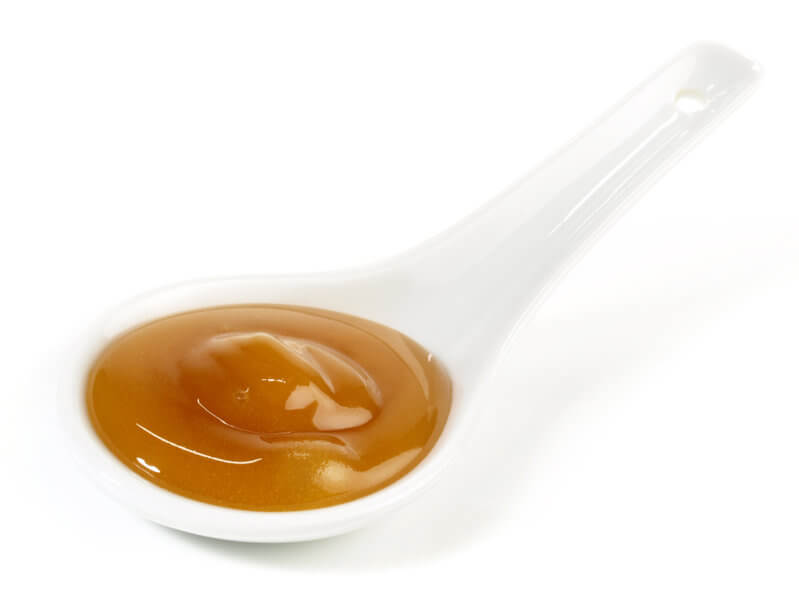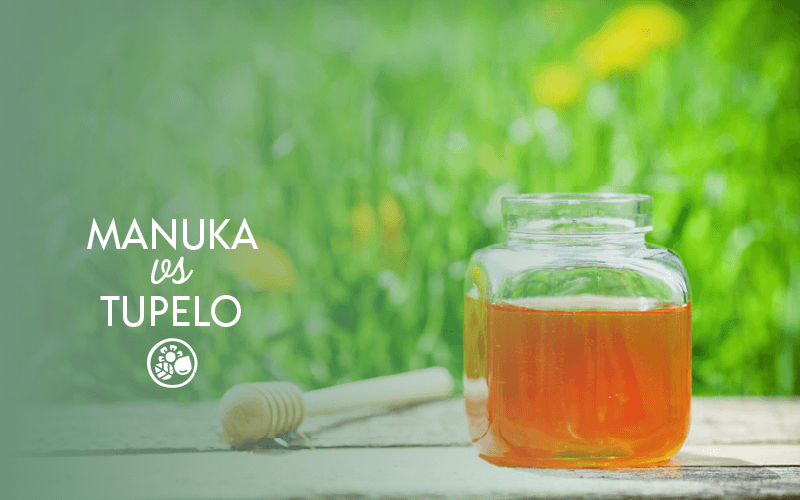The variety of honey products available to consumers these days is enough to overwhelm almost anyone. Two such options are the Manuka and Tupelo varieties, and in this article, we’ll be doing a complete comparison of Manuka honey vs Tupelo honey and comparing all of their differences so that you can compare and make an educated decision for yourself.
In short, the main difference between Manuka honey vs Tupelo honey is that the Manuka variety has greater medicinal properties due to its Methylglyoxal (MGO) content, but that also makes it more expensive and more difficult to source. Tuplo honey, on the other hand, has less calories per serving and a milder flavor.
If you’d like to know more about how these two nectars differ then continue reading for a more in-depth analysis.
About Manuka Honey

Manuka honey is a monofloral honey produced from the nectar of the Manuka tree.
The Manuka tree, also known as Leptospermum scoparium, is native to New Zealand and to parts of Australia as well.
Manuka honey has been used for centuries by the Maori people of New Zealand for its medicinal properties. It is unique because it contains high levels of Methylglyoxal (MGO) — a compound that gives Manuka honey its antibacterial and healing properties. Manuka honey has been shown to be effective in treating wounds, digestive disorders and skin conditions.
Additionally, Manuka honey has antimicrobial properties that make it effective against bacteria such as MRSA.
About Tupelo Honey

Tupelo honey is a monofloral honey produced from the nectar of the Tupelo tree. The Tupelo tree, also known as Nyssa sylvatica, is native to the southeastern United States.
Tupelo honey has been used for centuries by Native Americans for its medicinal properties. Tupelo honey is unique because it contains high levels of fructose and glucose, which give it its characteristic sweetness.
Additionally, and much like its Manuka counterpart, Tupelo honey has antibacterial and anti-inflammatory properties.
Manuka Honey vs Tupelo Honey
Although Manuka honey and Tupelo honey share some similarities, there are also some important differences between these two types of honey. Let’s have a look at some of the key differences between Manuka honey vs Tupelo honey.
Nutritional Differences
When it comes to nutrition, Manuka honey and Tupelo honey are both similar. Both types of honey contain vitamins, minerals, and antioxidants. However, there are some slight differences in the nutritional content of these two nectars.
Let’s have a look at how the two compare in terms of nutritional contents:
A single 1-tablespoon serving of Manuka honey contains:
- Calories: 70
- Total carbohydrates: 17g
By comparison, a single 1-tablespoon serving of Tupelo honey contains:
- Calories: 45
- Total carbohydrates: 12g
As you can see, Manuka honey contains nearly double the calories of Tupelo honey per serving and also contains significantly more carbohydrates.
Finally, Manuka honey has a higher concentration of Methylglyoxal (MGO) than Tupelo honey. Which, as we discussed earlier, is responsible for many of Manuka honey’s medicinal properties.
This suggests that there is a tradeoff to be made between Manuka honey vs Tupelo honey: the former has greater medicinal properties, but the latter has less calories and less carbohydrates per serving.
Potential Medicinal Uses
As previously mentioned, Manuka honey contains higher levels of Methylglyoxal (MGO) than Tupelo honey — the compound that gives this sweet nectar its healing properties. In fact, Manuka honey has no shortage of benefits when applied to the skin.
Tupelo honey, on the other hand, has also been used in a medicinal capacity, but more research is needed to support these claims.
How They’re Used As Ingredients
Another consideration you may make when comparing Manuka honey vs Tupelo honey is how they’re used as ingredients, and as it turns out, both Manuka and Tupelo honey work fantastically as ingredients in baking.
Manuka honey can be used to sweeten baked goods or to add flavor to savory dishes.
Likewise, Tupelo honey can also be used as a sweetener for various baked goods.
Check out some of the following recipes we’ve found on the internet that include the use of Manuka honey:
- Manuka Honey Cake: A delicious and easy-to-make cake that is perfect for any occasion.
- Spiced Honey Drizzle Cake: A moist and flavorful cake that is perfect for a summer picnic.
In addition, the following recipes all include the use of Tupelo honey:
- Tupelo Honey Cake A delicious and easy-to-make cake that is perfect for any occasion.
- Glazed Honey and Lemon Pound Cake A moist and flavorful cake that is perfect for a summer picnic.
- Tupelo Honey Ice Cream: A sweet and creamy ice cream that is perfect for a hot summer day.
As you can see, Manuka honey and Tupelo honey can both be used in a variety of recipes.
Differences In Taste
Manuka honey and Tupelo honey each have different tastes.
Manuka honey has a rich, intense flavor with a slightly bitter aftertaste. Tupelo honey, on the other hand, has a milder flavor with a sweet, floral taste.
Price
When it comes to the strain these sweeteners will place on your pocketbook, it turns out Manuka honey is generally more expensive than Tupelo honey. This is because Manuka honey is produced in limited quantities and is only found in certain parts of the world.
Additionally, Manuka honey contains higher levels of Methylglyoxal (MGO), which makes it more sought-after for its medicinal properties.
Tupelo honey is less expensive than Manuka honey because it is produced in greater quantities and is found in more parts of the world. And considering that Tupelo honey does not contain as high of levels of MGO, this makes it less sought-after than its Manuka counterpart.
In Summary
Manuka honey and Tupelo honey are both unique types of honey with their own set of benefits. Although they share some similarities, there are also some important differences between these two types of honey.
When it comes to nutrition, Manuka honey edges out the Tupelo variety in terms of vitamins, minerals, and medicinal compounds.
Tupelo honey, on the other hand, can serve as a lower-calorie alternative to the Manuka variety that costs less and is easier to find in stores — another consideration to keep in mind when comparing Manuka honey vs Tupelo honey.

